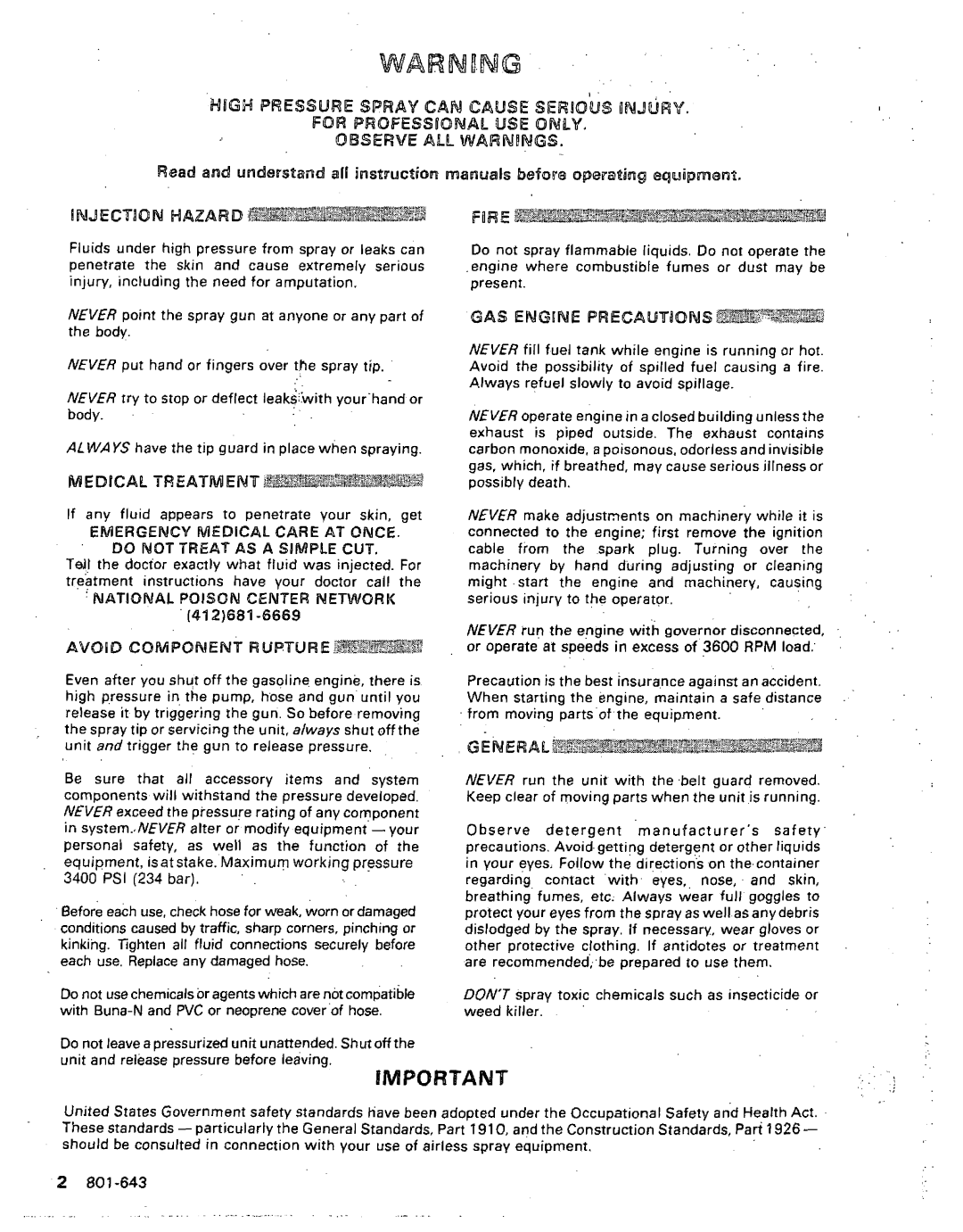
INJECTION HAZARD | %i FBWE | |
Fluids under high pressure from | spray or leaks can | Do not spray flammable liquids. Do not operate the |
penetratetheskinandcauseextremelyserious | .enginewherecombustiblefumes or dust may be | |
injury, including the need for amputation. | present. | |
NEVER point the spray gun at anyoneor any part of | G A S ENQIINE PRECAUTIONS | |
the body. |
|
|
NEVER fill fuel tank while engine is running or hot.
NEVER put hand or fingers over the spray tip.Avoidthepossibility of spilledfuelcausing a fire. Always refuel slowly to avoid spillage.
NEVER try to stop or deflect leak$with your.hand or |
|
|
|
|
|
|
|
|
| |||
body. |
|
|
| NEVER operate | enginein a closedbuilding unless the |
|
| |||||
ALWAYS have the tip guard in place when spraying. | exhaustispipedoutsideTheexhaustcontains. |
|
|
|
| |||||||
carbon monoxide, apoisonous. odorlessand invisible |
|
| ||||||||||
MEDICAL TREATMENBi |
|
| gas, which, if breathed, may cause serious illness or |
|
| |||||||
|
| possibly death. |
|
|
|
|
|
|
| |||
Ifanyfluid | appears topenetrateyour | skin,get | NEVER make adjustments on machinery while | it is |
|
| ||||||
EMERGENCY MEDICAL CARE AT ONCE. | connectedtothe | engine; | firstremovetheignition |
|
| |||||||
DO NOT TREAT AS A SIMPLE CUT . | cablefromthe | spark | plugTurning. | overthe |
|
| ||||||
Tell the doctor exactly what fluid was injected. For | machinery by handduringadjustingorcleaning |
|
|
| ||||||||
treatmentinstructionshaveyourdoctorcallthe |
|
| might.starttheengineandmachinery.causing |
|
|
|
| |||||
~ NATIONAL POISON CENTER NETWORK | serious injury to the operator. |
|
|
|
|
| ||||||
|
|
| NEVER run the engine with governordisconnected, |
|
| |||||||
AVOID COMPONENT RUPTURE |
|
|
|
| ||||||||
|
| or operate at speeds in excess of 3600 RPM load: |
|
| ||||||||
Even after you shut off the gasoline engine, there is | Precaution is the best insurance | against | anaccident. |
|
| |||||||
high p.ressure in the pump, hose and gun'until you | When starting the engine, maintain a safe distance |
|
| |||||||||
release it by triggering the gun.So before removing | frommovingpartsofequipment.the. |
|
|
|
| . . |
|
| ||||
the spray tip or servicing the unit, always shut offthe | G | E | ~ | ~ | R | ~ | ~ | ~ | ~ | |||
unit and trigger the gun to release pressure. | ||||||||||||
Be surethatallaccessoryitemsandsystem |
|
| NEVER runtheunitwiththe.beltguard | removed. |
|
| ||||||
components will withstand the pressure developed, | Keep clear of moving parts when the unit is running. |
|
| |||||||||
NEVER exceed the pressure ratingof any component |
|
|
|
|
|
|
|
|
| |||
in system.,NEVER alter or modify equipment | Observedetergentmanufacturer'ssafety |
|
|
|
| |||||||
personal safety, as well as thefunction | ofthe | precautions. Avoid~getting detergentor other liquids |
|
| ||||||||
equipment, isatstake. Maximum workingpressure | in your eyes. Follow the directions on the.container |
|
| |||||||||
3400 PSI (234bar). |
|
| regardingconract | with | eyes,, | nose, | and | skin, |
|
| ||
Before each use, check hosefor weak, worn ordamaged | breathingfumes, | etc: Alwayswearfull | goggles to |
|
| |||||||
protect your eyesfrom the | sprayas well as any | debris |
|
| ||||||||
conditions caused by traffic, sharp corners, pinching or | dislodged by the spray. If necessary, wear gloves or |
|
| |||||||||
kinking.Tightenall fluid connectionssecurelybefore | otherprotectiveclothing. | If antidotesortreatment |
|
| ||||||||
each use.Replace any damaged hose. |
|
| are recommended,.be prepared to use them. |
|
|
| ||||||
Do not usechemicalsoragentswhich are not | compatible | DON'T spray toxic chemicals such as insecticide or |
|
| ||||||||
with | weed killer. |
|
|
|
|
|
|
| ||||
Do not leave a oressurizedunit unattended. ~~~ Shutoff the~ |
|
|
|
|
|
|
|
|
| |||
unit and release pressure before leaving. |
| IMPORTANT |
|
|
|
|
|
|
|
| ||
|
|
|
|
|
|
|
|
| . . | , | ||
United States Government safety standards have been adopted under the Occupational Safety and Health Act. These standards
. .
2
